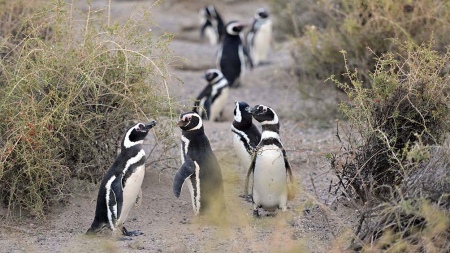The Magellan penguin, ambassador of Patagonia, is one of the most abundant seabirds that reproduces in our country and it is estimated that around a million couples make up its populationten times greater than that of seagulls.
According to the Centro Nacional Patagonico (Centap-Conicet), in the collective imagination the penguin is associated with places with icy climates, however the Magellan, Humboldt, South African and Galapagos penguins are four species of the same genus to which It is called “temperate water penguins”.
“One can imagine that the seagull is the most abundant bird in Patagonia, however the penguin population is ten times higher and they have a very interesting social life,” explained Marcelo Bertellotti, an independent researcher from Conicet at the Centro Nacional Patagonico ( Cenpat-Conicet).
They nest in the southern conein Chile and Argentina from September to March, and during the autumn and winter they migrate towards northern waters.

In its migratory routes it usually reaches places with high temperatures, it leaves Patagonia behind schools of anchovies and goes up the Atlantic towards the south of Brazil, even They can reach the height of Rio de Janeiro.
They travel five thousand kilometers a year from southern Argentina to Rio de Janeiro in Brazildata that comes from a study published in the journal Biological Conservation, led by David Stokes and in which Pablo García Borboroglu, an independent researcher from Conicet at Cenpat, participated.
They are together during reproduction in the almost six months that they spend on land and they separate when migrating.
The following spring, the males return to live in the same nest they occupied the previous season and are reunited with the females.
It is fully amphibious and spends a part of its life on land to nest, lay eggs and raise its young, but half of its existence is spent only in the sea.

The Penguins spend more than 80% of their lives in water and the bodily adaptations that allow us to explain this ability come from the past.
They lost their ability to fly 60 million years agobefore the formation of the polar ice caps and since then their life characteristics have been shaped by rising and falling temperatures, and their bodies are highly specialized for some of the most extreme conditions on Earth.
Like seabirds in general, penguins are prone to monogamy: pairs that come together to mate will almost certainly meet again in subsequent years.
“They have a cognitive memory that allows them to find and return to their nest, a tiny place from which they had left the previous season, after crossing the immense sea,” argued Bertellotti, an argument that contradicts the colonizer Vasco da Gama, who upon meeting them described them as “silly birds”.
The Aves Argentinas site maintained that adults have a high survival rate of more than 90%, while that of juveniles during the first year is very low, approximately 20%.
















